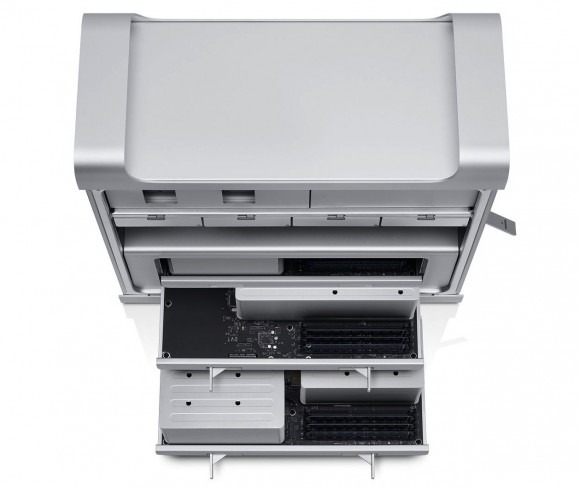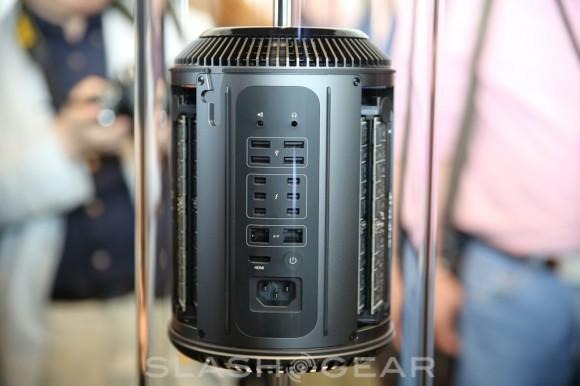Apple's Mac Pro 2013 And The Form Vs. Function War
We're about to see another of Apple's big experiments, and this time it's pro-users who are under the microscope. The test machine: the Mac Pro 2013. The question: just how important is upgrade-potential for so-called professional users, can fast external devices coax approval out of that audience, and will the offbeat design of the new high-end Mac convince us that power needn't be contained in a huge desktop?
Apple's new Mac Pro 2013 was arguably the star hardware of WWDC 2013. Yes, the new Haswell-powered MacBook Air is available today, rather than some nebulous promised time later in the year, and 12 hours of battery life – if it can indeed deliver on that – is impressive, but the ultraportable paled in comparison to the compact powerhouse Apple revealed.
Even before Phil Schiller had finished breathlessly announcing the new high-end model, though, long-standing Pro users were voicing their doubts. The Mac Pro has always been Apple's zero-compromise machine; yes, it's been aesthetically not-ugly, but the primary goal has been funneling the greatest amount of power into its footprint.
So, there's been room for four internal hard drives and two optical drives, up to eight memory slots (four per processor), three spare PCIe 2.0 slots – full-length, naturally – and everything easily accessed in a sliding, modular design. Form most definitely followed function in the old Mac Pro; that it was handsome, in a brutalist architecture way, was a designer's afterthought around an engineer's forward-thinking.

The cynic might say that Apple hates post-purchase upgrades. Most of its Macs of recent years have edged away from user-accessible update potential, whether they're destined for your lap or your desktop. The MacBook Air is so packed full of proprietary components that it's prohibitively expensive if you want to swap out the flash storage for a bigger drive; the fact that the processor and memory are soldered in place means switching them is a non-starter.
The MacBook Pro used to have an active underground of owners tweaking their systems, whether that be pushing in more RAM or ditching the optical drive in favor of a second drive bay. With the advent of the Retina Display version, however, upgrade possibilities pretty much sank to Air-levels.
Over on the desktop, the situation hasn't been much better. The Mac Mini gives access to its memory, at least, with a panel on the base, but the storage is buried away and demands near-total dismemberment to get to it. The 21.5-inch iMac doesn't even give you that; you need to splash out on the 27-inch version if you want the privilege of putting in your own memory. Both trade standardized storage for slimline form-factors.

For Mac Pro addicts, then, the idea of a new model was a mixed blessing. On the one hand, the old Pro had languished for too long with increasingly passé specifications – it was being regularly outperformed by high-end PCs, for instance, and Apple gave no impression it intended to address that. On the other, if Apple was true to form, any new Mac Pro might sacrifice the flexibility owners had come to love in the name of style and the new company creed that the only upgrades that really matter are those that get added as cost-options at the point of purchase.
Both came true. Full specifications of the Mac Pro 2013 haven't been confirmed – Apple is no doubt still tweaking them – but it's already promising to be monstrous in its capabilities. The combination of new Xeon processors and workstation-class dual-GPUs, not to mention faster solid-state storage, is already adding up to a machine that Apple claims is several times faster than its predecessor.
More on the new Mac Pro 2013 in our eyes-on report from WWDC 2013
It also achieves that at a fraction of the size, and therein lies the big problem. The new Mac Pro is, if anything, the greatest example of Apple's baroque custom packaging we've seen to-date: a never-before-seen cooling system, built around a common aluminum core; proprietary PCI Express storage; what are shaping up to be custom ATI graphics.
There are no spare drive bays – in fact, there's no SATA connectivity whatsoever, for older types of drives. The RAM is accessible, in fanning slots that flare out from either side of the logic board, but storage is shaping up to be as limiting a factor (in no small part around what you can afford) as in the MacBook Air and MacBook Pro. Even notorious Mac upgrade merchant OWC has only committed to a memory upgrade option, promising 32GB per slot for a system maximum of 128GB.

There's a flip-side, of course. The exact upgrade possibilities of the old Mac Pro were always somewhat questionable, in practice. Yes, it used standard-sized components, but only certain graphics cards were supported, and they could be considerably more expensive than their Windows counterparts. Failed power supply? Don't assume you can slot in a generic ATX replacement, since Apple's desktop wasn't designed to work with them.
In short, upgrading a Mac has always been more trouble than, say, a Windows PC. Apple's argument with the Mac Pro 2013, it appears, is that if connectivity standards – like Thunderbolt 2 – are going to deliver such high performance, then why design a form-factor that sets aside internal space for an update that might well never happen?
The drawback of course is cost and availability. Thunderbolt has been around since early 2011, when Apple debuted it on the MacBook Pro, but more than two years later and accessories that use the connector are still in short supply. Those that are on the market are expensive, often wildly so, and it's tough to see the Mac Pro's push for Thunderbolt 2 doing anything to address that.

On the one hand, there's a good argument to be made for your workstation to be an expansible-hub. A compact central "power station" with the flexibility – and speed – to connect to the user's own choice of external add-ons, without forcing them to give up desk space to drive-bays they might never fill, or card slots that may never be occupied.
On the other is years of experience that, when it comes to being expansible, anything that doesn't back you into using a fancy connector or a limited-availability port usually makes for a cheaper, more customizable experience.
The stage is set for Apple's toughest audience to vote with their wallets this year. Some are already convinced; others are taking a wait-and-see approach, especially given Apple is yet to confirm final pricing. Either way, the rest of the computing world – which so often follows Apple's lead – will undoubtedly be watching closely as the line between style and self-determination is drawn.
Get all you need to know on the Mac Pro 2013 in our SlashGear 101
